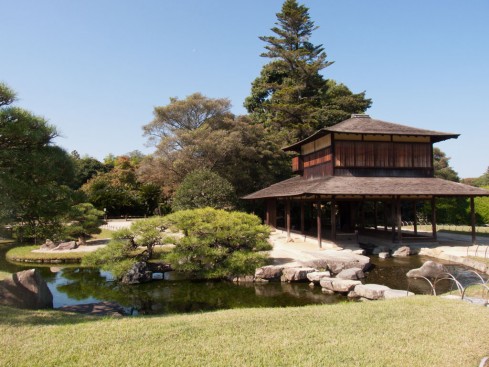Okayama, located near the southwestern tip of Honshu, is home to the famous Korakuen Garden, which is apparently included in some classic list of the “The Three Most Beautiful Gardens in Japan.”
Tsunamasa Ikeda, the local feudal lord, ordered its construction beginning in 1687. With one exception described below its appearance is much the same as it was during the Edo Period.
The name “Korakuen” comes from the 4-kanji aphorism “sen yuu kou raku” (“suffer now, pleasure later), implying that the garden was a well-earned reward for the samurai nobility who relaxed there.
The large guest house near the main entrance was used to entertain visiting dignitaries.

The guest house is positioned to provide a particularly good view of the central part of the garden.

Workmen clean the ornamental stream in front of the Renchi-kan teahouse.

The artificial hill in the center provides an excellent view of the entire garden.

The back part of the garden, not visible from the main guest house, was originally planted with rice and tea. Most of this has since been converted to lawns and landscaping but some token plots remain.

A visiting class of elementary school students harvests the rice.













>4-kanji aphorism “sen yuu kou raku”
To be precise, the name comes from Fan Zhongyan’s Memorial to Yueyang Tower, written in Song dynasty. For the actual meaning of this phrase, you can read Wikipedia’s entry on him, which offers a few possible translations. The idea is actually deeper than “pleasure after suffering”, and very Confucian :-) .
http://en.wikipedia.org/wiki/Fan_Zhongyan
Also, according to the Japanese Wikipedia, this garden was renamed Korakuen at 1874, after the Meiji government making it into a public park, so the name reflects the ideology of the Meiji regime, rather than that of samurais.
>renamed Korakuen at 1874
Sorry, should be “1871”.